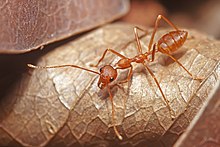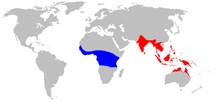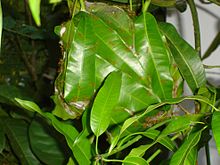
Ants are eusocial insects of the family Formicidae and, along with the related wasps and bees, belong to the order Hymenoptera. Ants evolved from vespoid wasp ancestors in the Cretaceous period. More than 13,800 of an estimated total of 22,000 species have been classified. They are easily identified by their geniculate (elbowed) antennae and the distinctive node-like structure that forms their slender waists.

Atta is a genus of New World ants of the subfamily Myrmicinae. It contains at least 17 known species.

Solenopsis invicta, the fire ant, or red imported fire ant (RIFA), is a species of ant native to South America. A member of the genus Solenopsis in the subfamily Myrmicinae, it was described by Swiss entomologist Felix Santschi as a variant of S. saevissima in 1916. Its current specific name invicta was given to the ant in 1972 as a separate species. However, the variant and species were the same ant, and the name was preserved due to its wide use. Though South American in origin, the red imported fire ant has been accidentally introduced in Australia, New Zealand, several Asian and Caribbean countries, Europe and the United States. The red imported fire ant is polymorphic, as workers appear in different shapes and sizes. The ant's colours are red and somewhat yellowish with a brown or black gaster, but males are completely black. Red imported fire ants are dominant in altered areas and live in a wide variety of habitats. They can be found in rainforests, disturbed areas, deserts, grasslands, alongside roads and buildings, and in electrical equipment. Colonies form large mounds constructed from soil with no visible entrances because foraging tunnels are built and workers emerge far away from the nest.

Fungus-growing ants comprise all the known fungus-growing ant species participating in ant–fungus mutualism. They are known for cutting grasses and leaves, carrying them to their colonies' nests, and using them to grow fungus on which they later feed.

Myrmecia is a genus of ants first established by Danish zoologist Johan Christian Fabricius in 1804. The genus is a member of the subfamily Myrmeciinae of the family Formicidae. Myrmecia is a large genus of ants, comprising at least 93 species that are found throughout Australia and its coastal islands, while a single species is only known from New Caledonia. One species has been introduced out of its natural distribution and was found in New Zealand in 1940, but the ant was last seen in 1981. These ants are commonly known as bull ants, bulldog ants or jack jumper ants, and are also associated with many other common names. They are characterized by their extreme aggressiveness, ferocity, and painful stings. Some species are known for the jumping behavior they exhibit when agitated.

Carpenter ants are large ants indigenous to many forested parts of the world.

The pharaoh ant is a small (2 mm) yellow or light brown, almost transparent ant notorious for being a major indoor nuisance pest, especially in hospitals. A cryptogenic species, it has now been introduced to virtually every area of the world, including Europe, the Americas, Australasia and Southeast Asia. It is a major pest in the United States, Australia, and Europe. The ant's common name is said to be derived from the mistaken belief that it was one of the biblical Egyptian (pharaonic) plagues.
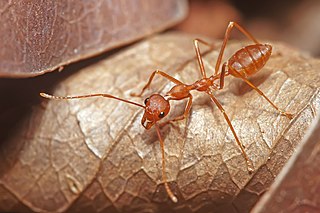
Oecophylla smaragdina is a species of arboreal ant found in tropical Asia and Australia. These ants form colonies with multiple nests in trees, each nest being made of leaves stitched together using the silk produced by the ant larvae: hence the name 'oecophylla' [Greek for 'leaf-house'].

The banded sugar ant, also known as the sugar ant, is a species of ant native to Australia. A member of the genus Camponotus in the subfamily Formicinae, it was described by German entomologist Wilhelm Ferdinand Erichson in 1842. Its common name refers to the ant's liking for sugar and sweet food, as well as the distinctive orange-brown band that wraps around its gaster.

Nothomyrmecia, also known as the dinosaur ant or dawn ant, is an extremely rare genus of ants consisting of a single species, Nothomyrmecia macrops. These ants live in South Australia, nesting in old-growth mallee woodland and Eucalyptus woodland. The full distribution of Nothomyrmecia has never been assessed, and it is unknown how widespread the species truly is; its potential range may be wider if it does favour old-growth mallee woodland. Possible threats to its survival include habitat destruction and climate change. Nothomyrmecia is most active when it is cold because workers encounter fewer competitors and predators such as Camponotus and Iridomyrmex, and it also increases hunting success. Thus, the increase of temperature may prevent them from foraging and very few areas would be suitable for the ant to live in. As a result, the IUCN lists the ant as Critically Endangered.

Iridomyrmex is a genus of ants called rainbow ants first described by Austrian entomologist Gustav Mayr in 1862. He placed the genus in the subfamily Dolichoderinae of the family Formicidae. It has 79 described species and five fossil species. Most of these ants are native to Australia; others are found in Asia and Oceania, and they have been introduced to Brazil, New Zealand, and the United Arab Emirates. Fossil species are known from China, France, and the United States.

The meat ant, also known as the gravel ant or southern meat ant, is a species of ant endemic to Australia. A member of the genus Iridomyrmex in the subfamily Dolichoderinae, it was described by British entomologist Frederick Smith in 1858. The meat ant is associated with many common names due to its appearance, nest-building behaviour and abundance, of which its specific name, purpureus, refers to its coloured appearance. It is among the best-known species of ant found throughout Australia; it occurs in almost all states and territories except for Tasmania. Its enormous distribution, aggression and ecological importance have made this ant a dominant species.

The Argentine ant is an ant native to northern Argentina, Uruguay, Paraguay, Bolivia and southern Brazil. This invasive species was inadvertently introduced by humans on a global scale and has become established in many Mediterranean climate areas, including South Africa, New Zealand, Japan, Easter Island, Australia, the Azores, Europe, Hawaii, and the continental United States. Argentine ants are significant pests within agricultural and urban settings, and are documented to cause substantial harm to communities of native arthropods, vertebrates, and plants within their invaded range.

The green-head ant is a species of ant that is endemic to Australia. It was described by British entomologist Frederick Smith in 1858 as a member of the genus Rhytidoponera in the subfamily Ectatomminae. These ants measure between 5 and 7 mm. The queens and workers look similar, differing only in size, with the males being the smallest. They are well known for their distinctive metallic appearance, which varies from green to purple or even reddish-violet. Among the most widespread of all insects in Australia, green-head ants are found in almost every Australian state, but are absent in Tasmania. They have also been introduced in New Zealand, where several populations have been established.

Ochetellus glaber is a species of ant native to Australia. A member of the genus Ochetellus in the subfamily Dolichoderinae, it was described by Austrian entomologist Gustav Mayr in 1862. Aside from Australia, O. glaber has been introduced to a number of countries, including China, India, Japan, New Zealand, the Philippines and the United States, where it has established itself in Hawaii and Florida. It has been found on Lord Howe Island, New Caledonia, Norfolk Island, Réunion, New Zealand, and the Solomon Islands. Compared with other ants, O. glaber is a small species, with workers measuring 2–3 mm (0.079–0.118 in). Males are the smallest at 1.6 mm (0.063 in), while the queens measure 5.2–5.5 mm (0.20–0.22 in). The ant's colour ranges from brown to black.

Pheidole megacephala is a species of ant in the family Formicidae. It is commonly known as the big-headed ant in the US and the coastal brown ant in Australia. It is a very successful invasive species and is considered a danger to native ants in Australia and other places. It is regarded as one of the world's worst invasive ant species.

Oecophylla longinoda is a species of arboreal ant found in the forested regions of tropical Africa. They are one of only two extant species of the genus Oecophylla, the other being O. smaragdina. They make nests in trees made of leaves stitched together using the silk produced by their larvae.
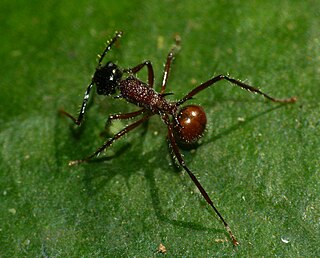
Polyrhachis is a genus of formicine ants found in the Old World with over 600 species. The genus is yet to be comprehensively resolved and contains many varied species including nest-weavers, swimming workers, soil and tree-dwellers. First fossil record of this genus was P. annosa from Miocene.

Myrmecia nigrocincta, commonly known as the jumper ant or jumping jack, is an ant of the genus Myrmecia. The species was first described by Frederick Smith in 1858. Colonies of this ant are abundant in eastern Australia. Ants of this species are known for their ability to jump up to 10 centimetres, and they also have a powerful, venomous sting. Rather than foraging on the ground, M. nigrocincta prefer to forage in trees where they are known to pollinate certain flowers.
This is a glossary of terms used in the descriptions of ants.
